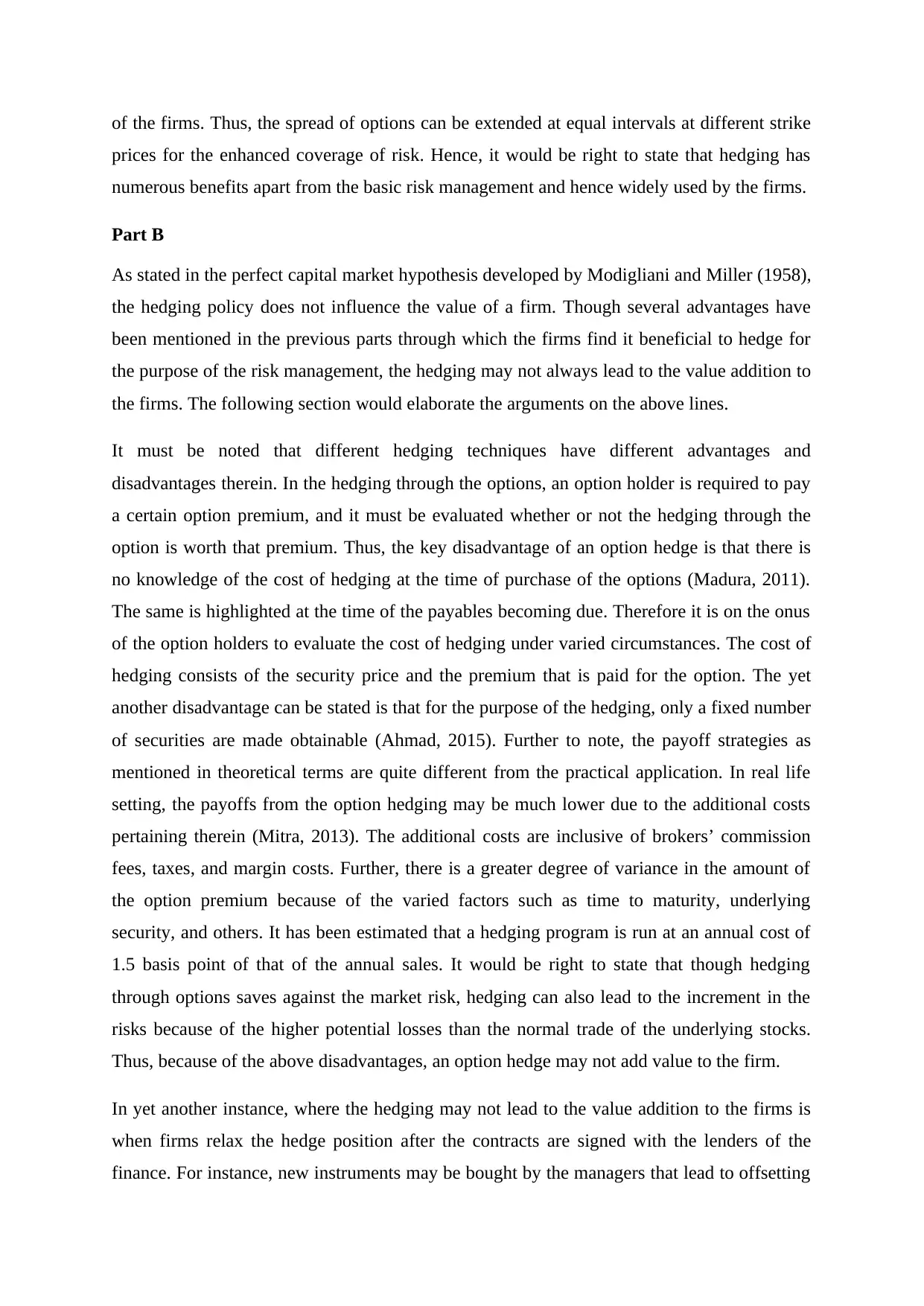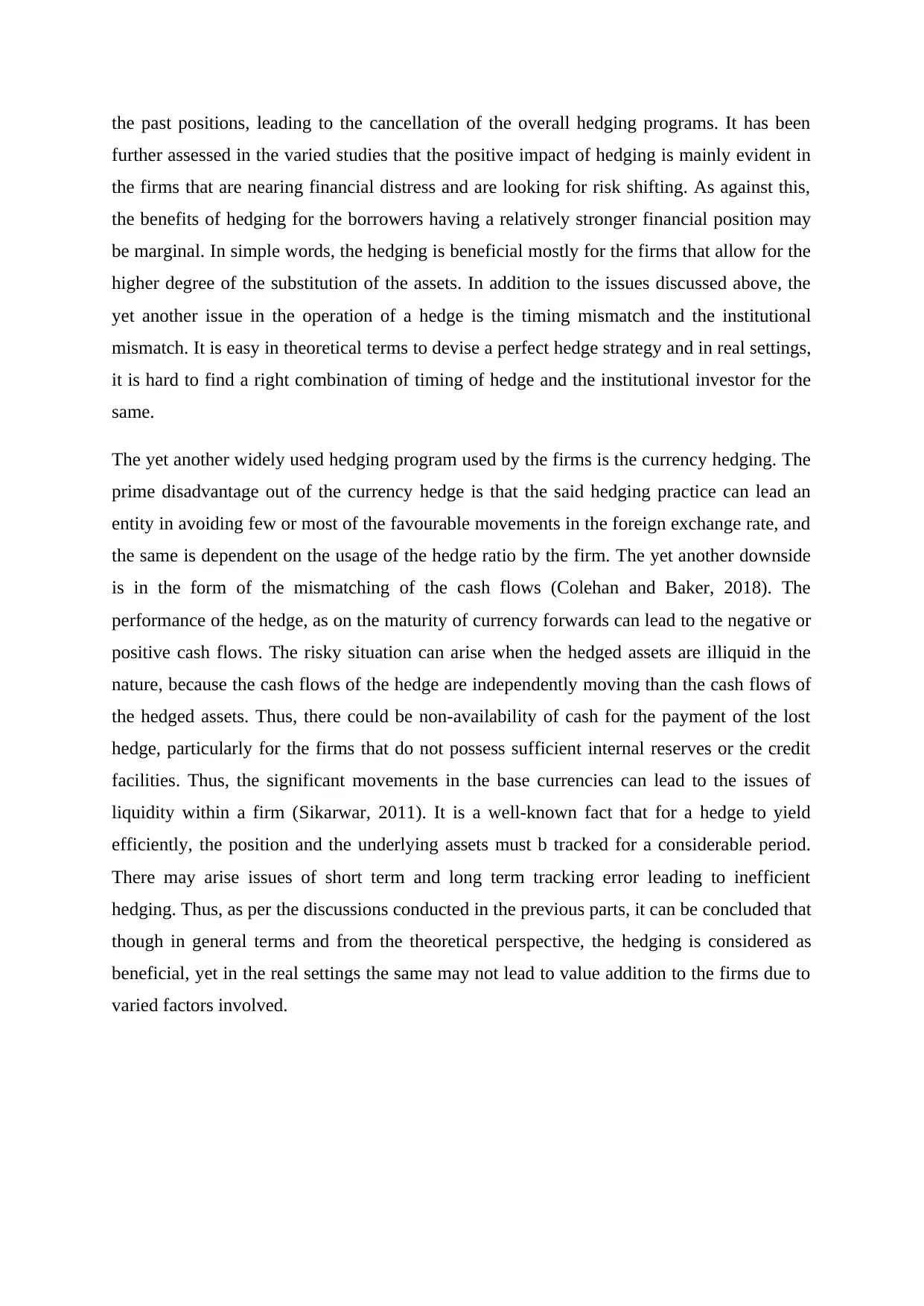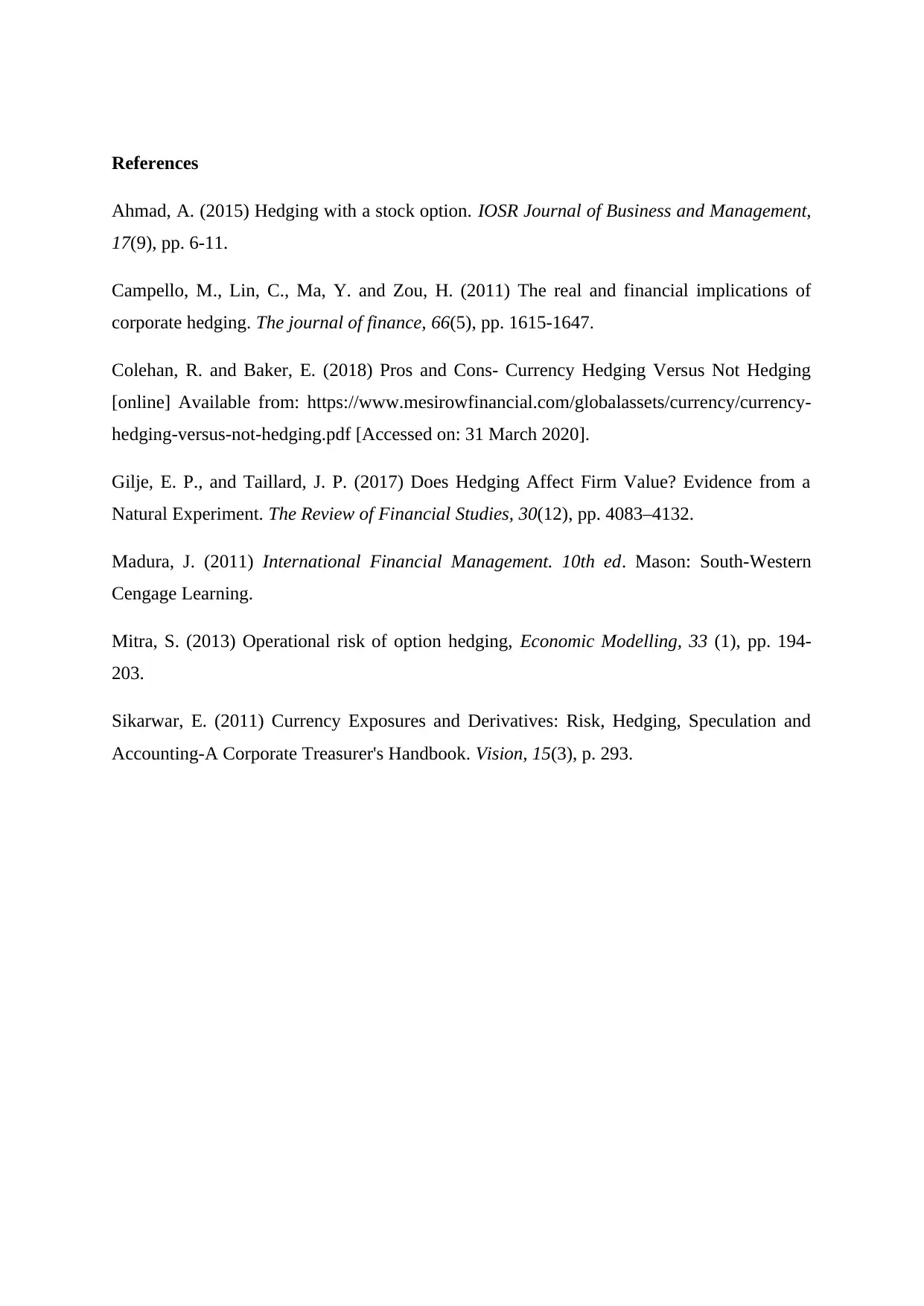Financial Risk Management: Corporate Hedging Techniques Analysis
VerifiedAdded on 2022/08/22
|5
|1770
|22
Report
AI Summary
This report provides a comprehensive analysis of corporate risk management through hedging. Part A explores the benefits of hedging, including limiting losses, maintaining liquidity, and protecting profits through various strategies like options and derivatives. It highlights how hedging can facilitate access to external financing. Part B delves into the potential drawbacks of hedging, referencing the Modigliani and Miller (1958) perfect capital market hypothesis. It discusses the disadvantages of option hedging, such as premium costs and limited security availability, as well as the potential for increased risks. The report also examines scenarios where hedging may not add value, including timing and institutional mismatches, and the disadvantages of currency hedging. The conclusion suggests that while hedging is theoretically beneficial, real-world factors can diminish its value for firms.

FINANCIAL RISK MANAGEMENT
Corporate risk management through hedging
Corporate risk management through hedging
Paraphrase This Document
Need a fresh take? Get an instant paraphrase of this document with our AI Paraphraser

Part A
The profitable management of a business organisation involves the accepting of some risks in
the business, while avoiding the others. One of the primary features of the contemporary
financial markets is that of the risk management. Risk management involves various
activities. It involves the study of the risk, evaluation of the costs of the risks and the worth of
it, review of the options available and adopting the best option as suited according to the
strength and weakness of the entity. Some of the key risks to which the entities and
individuals are involved are the changes in the commodity prices, interest rates, exchange
rates and the equity prices. One of the prime means of the risk management is through
hedging. Hedging refers to the practice of ensuring against the financial risk by offsetting the
position to another security or commodity with the use of the derivative securities. The
practice includes buying and selling of futures, forwards or option by which the risk exposure
is offset in the market. Hedging can be employed in various areas such as securities market,
interest rate, commodities market, currencies and even weather. The benefits availed by the
firms through the hedging are listed as follows.
Hedging puts limitation of losses to a great extent, by the use of the various strategies. Most
of the hedging is done through the derivatives, in which the option is the most usual kind of
derivative used. For instances, it is feared by the firm that the prices of the securities may go
down in which it has invested in. The risk is hedged by paying the premium and buying an
option to sell the said securities at a decided price. Thus, if in case the prices fall, the entity
can exercise the put option and the money invested would remain secure in exchange of the
premium amount. Yet another benefit reaped by the firms for the risk management through
hedging is in the form of the maintenance of liquidity leading to avoidance of financial
distress and bankruptcy issues within an entity (Gilje and Taillard, 2017). This is when the
firms use the derivatives based on the macroeconomic conditions and thus the risk is hedged
selectively. One such practice involved is the timing the loans in such a way where there is a
correlation between the hedging and the aggregate conditions. It has been assessed in various
studies that when the position of a firm is efficiently hedged, there is 20% lesser likeliness
that there would be capital expenditure restrictions in the loan agreements (Campello et.al,
2011). Thus, it would be right to state that hedging leads to the ease in the external financing
access and thus often used by the firms. The yet another benefit of hedging is that it leads to
the protection of the profits in customised way as the risk solution providers and the
commodity trade banks combine varied risk mitigation mechanisms as per the requirements
The profitable management of a business organisation involves the accepting of some risks in
the business, while avoiding the others. One of the primary features of the contemporary
financial markets is that of the risk management. Risk management involves various
activities. It involves the study of the risk, evaluation of the costs of the risks and the worth of
it, review of the options available and adopting the best option as suited according to the
strength and weakness of the entity. Some of the key risks to which the entities and
individuals are involved are the changes in the commodity prices, interest rates, exchange
rates and the equity prices. One of the prime means of the risk management is through
hedging. Hedging refers to the practice of ensuring against the financial risk by offsetting the
position to another security or commodity with the use of the derivative securities. The
practice includes buying and selling of futures, forwards or option by which the risk exposure
is offset in the market. Hedging can be employed in various areas such as securities market,
interest rate, commodities market, currencies and even weather. The benefits availed by the
firms through the hedging are listed as follows.
Hedging puts limitation of losses to a great extent, by the use of the various strategies. Most
of the hedging is done through the derivatives, in which the option is the most usual kind of
derivative used. For instances, it is feared by the firm that the prices of the securities may go
down in which it has invested in. The risk is hedged by paying the premium and buying an
option to sell the said securities at a decided price. Thus, if in case the prices fall, the entity
can exercise the put option and the money invested would remain secure in exchange of the
premium amount. Yet another benefit reaped by the firms for the risk management through
hedging is in the form of the maintenance of liquidity leading to avoidance of financial
distress and bankruptcy issues within an entity (Gilje and Taillard, 2017). This is when the
firms use the derivatives based on the macroeconomic conditions and thus the risk is hedged
selectively. One such practice involved is the timing the loans in such a way where there is a
correlation between the hedging and the aggregate conditions. It has been assessed in various
studies that when the position of a firm is efficiently hedged, there is 20% lesser likeliness
that there would be capital expenditure restrictions in the loan agreements (Campello et.al,
2011). Thus, it would be right to state that hedging leads to the ease in the external financing
access and thus often used by the firms. The yet another benefit of hedging is that it leads to
the protection of the profits in customised way as the risk solution providers and the
commodity trade banks combine varied risk mitigation mechanisms as per the requirements

of the firms. Thus, the spread of options can be extended at equal intervals at different strike
prices for the enhanced coverage of risk. Hence, it would be right to state that hedging has
numerous benefits apart from the basic risk management and hence widely used by the firms.
Part B
As stated in the perfect capital market hypothesis developed by Modigliani and Miller (1958),
the hedging policy does not influence the value of a firm. Though several advantages have
been mentioned in the previous parts through which the firms find it beneficial to hedge for
the purpose of the risk management, the hedging may not always lead to the value addition to
the firms. The following section would elaborate the arguments on the above lines.
It must be noted that different hedging techniques have different advantages and
disadvantages therein. In the hedging through the options, an option holder is required to pay
a certain option premium, and it must be evaluated whether or not the hedging through the
option is worth that premium. Thus, the key disadvantage of an option hedge is that there is
no knowledge of the cost of hedging at the time of purchase of the options (Madura, 2011).
The same is highlighted at the time of the payables becoming due. Therefore it is on the onus
of the option holders to evaluate the cost of hedging under varied circumstances. The cost of
hedging consists of the security price and the premium that is paid for the option. The yet
another disadvantage can be stated is that for the purpose of the hedging, only a fixed number
of securities are made obtainable (Ahmad, 2015). Further to note, the payoff strategies as
mentioned in theoretical terms are quite different from the practical application. In real life
setting, the payoffs from the option hedging may be much lower due to the additional costs
pertaining therein (Mitra, 2013). The additional costs are inclusive of brokers’ commission
fees, taxes, and margin costs. Further, there is a greater degree of variance in the amount of
the option premium because of the varied factors such as time to maturity, underlying
security, and others. It has been estimated that a hedging program is run at an annual cost of
1.5 basis point of that of the annual sales. It would be right to state that though hedging
through options saves against the market risk, hedging can also lead to the increment in the
risks because of the higher potential losses than the normal trade of the underlying stocks.
Thus, because of the above disadvantages, an option hedge may not add value to the firm.
In yet another instance, where the hedging may not lead to the value addition to the firms is
when firms relax the hedge position after the contracts are signed with the lenders of the
finance. For instance, new instruments may be bought by the managers that lead to offsetting
prices for the enhanced coverage of risk. Hence, it would be right to state that hedging has
numerous benefits apart from the basic risk management and hence widely used by the firms.
Part B
As stated in the perfect capital market hypothesis developed by Modigliani and Miller (1958),
the hedging policy does not influence the value of a firm. Though several advantages have
been mentioned in the previous parts through which the firms find it beneficial to hedge for
the purpose of the risk management, the hedging may not always lead to the value addition to
the firms. The following section would elaborate the arguments on the above lines.
It must be noted that different hedging techniques have different advantages and
disadvantages therein. In the hedging through the options, an option holder is required to pay
a certain option premium, and it must be evaluated whether or not the hedging through the
option is worth that premium. Thus, the key disadvantage of an option hedge is that there is
no knowledge of the cost of hedging at the time of purchase of the options (Madura, 2011).
The same is highlighted at the time of the payables becoming due. Therefore it is on the onus
of the option holders to evaluate the cost of hedging under varied circumstances. The cost of
hedging consists of the security price and the premium that is paid for the option. The yet
another disadvantage can be stated is that for the purpose of the hedging, only a fixed number
of securities are made obtainable (Ahmad, 2015). Further to note, the payoff strategies as
mentioned in theoretical terms are quite different from the practical application. In real life
setting, the payoffs from the option hedging may be much lower due to the additional costs
pertaining therein (Mitra, 2013). The additional costs are inclusive of brokers’ commission
fees, taxes, and margin costs. Further, there is a greater degree of variance in the amount of
the option premium because of the varied factors such as time to maturity, underlying
security, and others. It has been estimated that a hedging program is run at an annual cost of
1.5 basis point of that of the annual sales. It would be right to state that though hedging
through options saves against the market risk, hedging can also lead to the increment in the
risks because of the higher potential losses than the normal trade of the underlying stocks.
Thus, because of the above disadvantages, an option hedge may not add value to the firm.
In yet another instance, where the hedging may not lead to the value addition to the firms is
when firms relax the hedge position after the contracts are signed with the lenders of the
finance. For instance, new instruments may be bought by the managers that lead to offsetting
⊘ This is a preview!⊘
Do you want full access?
Subscribe today to unlock all pages.

Trusted by 1+ million students worldwide

the past positions, leading to the cancellation of the overall hedging programs. It has been
further assessed in the varied studies that the positive impact of hedging is mainly evident in
the firms that are nearing financial distress and are looking for risk shifting. As against this,
the benefits of hedging for the borrowers having a relatively stronger financial position may
be marginal. In simple words, the hedging is beneficial mostly for the firms that allow for the
higher degree of the substitution of the assets. In addition to the issues discussed above, the
yet another issue in the operation of a hedge is the timing mismatch and the institutional
mismatch. It is easy in theoretical terms to devise a perfect hedge strategy and in real settings,
it is hard to find a right combination of timing of hedge and the institutional investor for the
same.
The yet another widely used hedging program used by the firms is the currency hedging. The
prime disadvantage out of the currency hedge is that the said hedging practice can lead an
entity in avoiding few or most of the favourable movements in the foreign exchange rate, and
the same is dependent on the usage of the hedge ratio by the firm. The yet another downside
is in the form of the mismatching of the cash flows (Colehan and Baker, 2018). The
performance of the hedge, as on the maturity of currency forwards can lead to the negative or
positive cash flows. The risky situation can arise when the hedged assets are illiquid in the
nature, because the cash flows of the hedge are independently moving than the cash flows of
the hedged assets. Thus, there could be non-availability of cash for the payment of the lost
hedge, particularly for the firms that do not possess sufficient internal reserves or the credit
facilities. Thus, the significant movements in the base currencies can lead to the issues of
liquidity within a firm (Sikarwar, 2011). It is a well-known fact that for a hedge to yield
efficiently, the position and the underlying assets must b tracked for a considerable period.
There may arise issues of short term and long term tracking error leading to inefficient
hedging. Thus, as per the discussions conducted in the previous parts, it can be concluded that
though in general terms and from the theoretical perspective, the hedging is considered as
beneficial, yet in the real settings the same may not lead to value addition to the firms due to
varied factors involved.
further assessed in the varied studies that the positive impact of hedging is mainly evident in
the firms that are nearing financial distress and are looking for risk shifting. As against this,
the benefits of hedging for the borrowers having a relatively stronger financial position may
be marginal. In simple words, the hedging is beneficial mostly for the firms that allow for the
higher degree of the substitution of the assets. In addition to the issues discussed above, the
yet another issue in the operation of a hedge is the timing mismatch and the institutional
mismatch. It is easy in theoretical terms to devise a perfect hedge strategy and in real settings,
it is hard to find a right combination of timing of hedge and the institutional investor for the
same.
The yet another widely used hedging program used by the firms is the currency hedging. The
prime disadvantage out of the currency hedge is that the said hedging practice can lead an
entity in avoiding few or most of the favourable movements in the foreign exchange rate, and
the same is dependent on the usage of the hedge ratio by the firm. The yet another downside
is in the form of the mismatching of the cash flows (Colehan and Baker, 2018). The
performance of the hedge, as on the maturity of currency forwards can lead to the negative or
positive cash flows. The risky situation can arise when the hedged assets are illiquid in the
nature, because the cash flows of the hedge are independently moving than the cash flows of
the hedged assets. Thus, there could be non-availability of cash for the payment of the lost
hedge, particularly for the firms that do not possess sufficient internal reserves or the credit
facilities. Thus, the significant movements in the base currencies can lead to the issues of
liquidity within a firm (Sikarwar, 2011). It is a well-known fact that for a hedge to yield
efficiently, the position and the underlying assets must b tracked for a considerable period.
There may arise issues of short term and long term tracking error leading to inefficient
hedging. Thus, as per the discussions conducted in the previous parts, it can be concluded that
though in general terms and from the theoretical perspective, the hedging is considered as
beneficial, yet in the real settings the same may not lead to value addition to the firms due to
varied factors involved.
Paraphrase This Document
Need a fresh take? Get an instant paraphrase of this document with our AI Paraphraser

References
Ahmad, A. (2015) Hedging with a stock option. IOSR Journal of Business and Management,
17(9), pp. 6-11.
Campello, M., Lin, C., Ma, Y. and Zou, H. (2011) The real and financial implications of
corporate hedging. The journal of finance, 66(5), pp. 1615-1647.
Colehan, R. and Baker, E. (2018) Pros and Cons- Currency Hedging Versus Not Hedging
[online] Available from: https://www.mesirowfinancial.com/globalassets/currency/currency-
hedging-versus-not-hedging.pdf [Accessed on: 31 March 2020].
Gilje, E. P., and Taillard, J. P. (2017) Does Hedging Affect Firm Value? Evidence from a
Natural Experiment. The Review of Financial Studies, 30(12), pp. 4083–4132.
Madura, J. (2011) International Financial Management. 10th ed. Mason: South-Western
Cengage Learning.
Mitra, S. (2013) Operational risk of option hedging, Economic Modelling, 33 (1), pp. 194-
203.
Sikarwar, E. (2011) Currency Exposures and Derivatives: Risk, Hedging, Speculation and
Accounting-A Corporate Treasurer's Handbook. Vision, 15(3), p. 293.
Ahmad, A. (2015) Hedging with a stock option. IOSR Journal of Business and Management,
17(9), pp. 6-11.
Campello, M., Lin, C., Ma, Y. and Zou, H. (2011) The real and financial implications of
corporate hedging. The journal of finance, 66(5), pp. 1615-1647.
Colehan, R. and Baker, E. (2018) Pros and Cons- Currency Hedging Versus Not Hedging
[online] Available from: https://www.mesirowfinancial.com/globalassets/currency/currency-
hedging-versus-not-hedging.pdf [Accessed on: 31 March 2020].
Gilje, E. P., and Taillard, J. P. (2017) Does Hedging Affect Firm Value? Evidence from a
Natural Experiment. The Review of Financial Studies, 30(12), pp. 4083–4132.
Madura, J. (2011) International Financial Management. 10th ed. Mason: South-Western
Cengage Learning.
Mitra, S. (2013) Operational risk of option hedging, Economic Modelling, 33 (1), pp. 194-
203.
Sikarwar, E. (2011) Currency Exposures and Derivatives: Risk, Hedging, Speculation and
Accounting-A Corporate Treasurer's Handbook. Vision, 15(3), p. 293.
1 out of 5
Related Documents
Your All-in-One AI-Powered Toolkit for Academic Success.
+13062052269
info@desklib.com
Available 24*7 on WhatsApp / Email
![[object Object]](/_next/static/media/star-bottom.7253800d.svg)
Unlock your academic potential
Copyright © 2020–2025 A2Z Services. All Rights Reserved. Developed and managed by ZUCOL.





